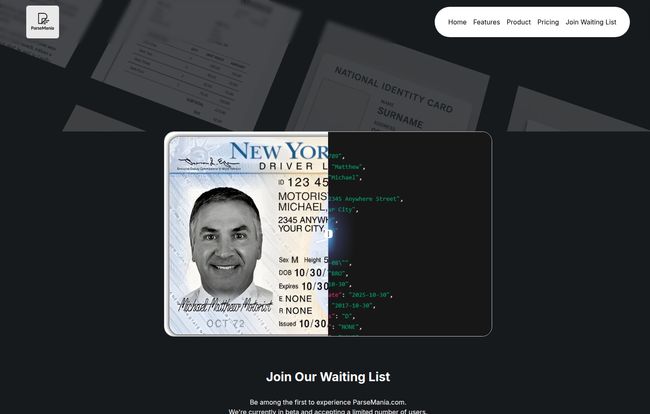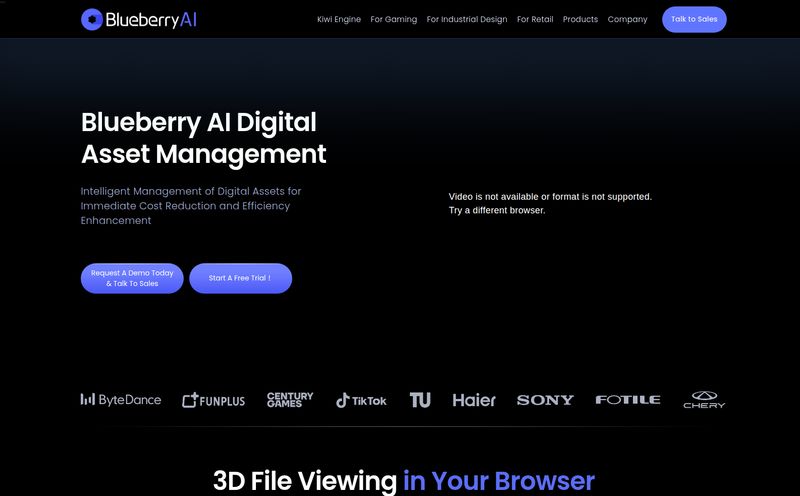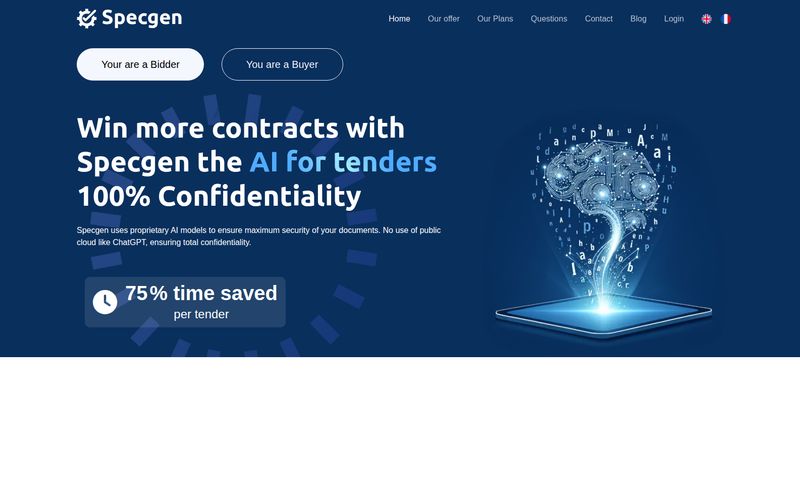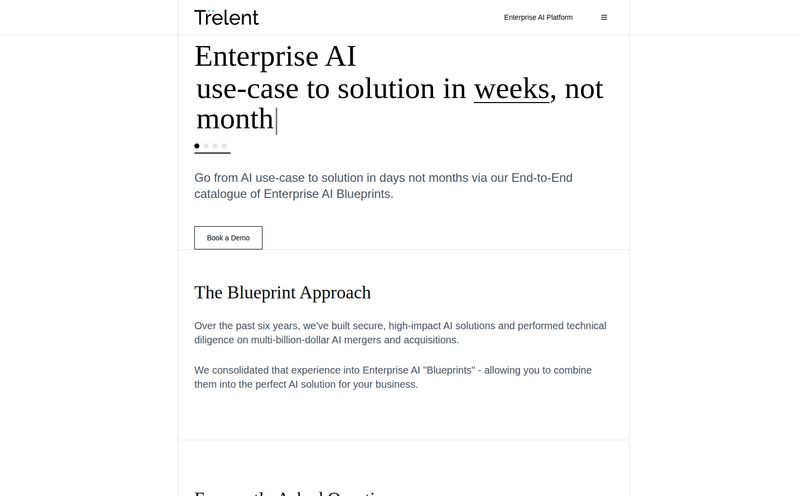If you've been in the digital marketing or operations game for any length of time, you've felt the pain. The soul-crushing, mind-numbing pain of manual data entry. We've all been there, hunched over a spreadsheet at 2 AM, fueled by lukewarm coffee and regret, manually copying and pasting data from a mountain of PDFs, invoices, or a horribly structured website.
It's a necessary evil, right? Or is it?
Every so often, a tool pops up on my radar that makes me sit up and pay attention. One that promises to slay that particular dragon. Today, that tool is ParseMania. It bills itself as an "AI-powered document processing and data extraction platform," which is a fancy way of saying it reads all your boring documents so you don’t have to. And I've gotta say, I'm intrigued.
So, What's the Big Deal with ParseMania?
In the simplest terms, ParseMania is designed to be your personal data-entry robot. You feed it unstructured chaos—think scanned receipts, complex invoices, product data from a competitor's website—and it spits out clean, structured, usable data. It’s like a universal translator, but instead of turning Spanish into English, it turns a messy PDF into a neat and tidy spreadsheet or a JSON file ready for your app.
This isn't just basic Optical Character Recognition (OCR) that pulls all the text and leaves you to sort it out. Oh no. The promise here is smart extraction. The AI is supposedly trained to understand the context of the data. It knows the difference between a subtotal, a tax amount, and a shipping fee. It can pick out a supplier's name from an invoice or a product SKU from a webpage. That’s the magic ingredient that separates a truly useful tool from a gimmick.

Visit ParseMania
The Three-Step Tango: How It All Works
The beauty of a good tool is its simplicity, and ParseMania seems to get that. Their whole workflow boils down to a pretty straightforward three-step process. It’s a bit like a digital assembly line for your data.
Step 1: Getting Your Data In (The Easy Part)
First, you have to give the machine something to work with. They've made this part incredibly flexible. You can upload files directly (PDFs, JPGs, you name it), which is perfect for that shoebox full of receipts you've been meaning to digitize. Or, you can just give it a URL and tell it to go fetch the data itself. For us SEO folks, the idea of pointing it at a website and letting it scrape structured data is… well, its' very appealing. For the more tech-savvy, there’s an API for direct integration, and they even mention scheduled crawling. Set it and forget it. I love that.
Step 2: The AI Magic Happens Here
Once ParseMania has the document or webpage, its AI core gets to work. This is the black box where the real magic is supposed to happen. It scans, identifies, and extracts the specific data points you need. You're not just getting a wall of text; you're getting neatly categorized information. Things like line items from an invoice, contact details from a business card, or even specific fields from a custom form. It also includes data validation, which is a huge plus. There's nothing worse than getting a bunch of automated data only to find out half of it is garbage.
Step 3: Getting Your Data Out (And Into Your Systems)
This might be the most important step. Great data is useless if it's trapped in a silo. ParseMania offers a ton of export options. You can download your freshly structured data as a CSV, JSON, Excel, or even a PDF file. But for my money, the real power comes from the integrations. You can push the data directly to another system using their API or, my personal favorite, Webhooks. This means the moment an invoice is processed by ParseMania, the data can automatically appear in your accounting software, your CRM, or a Google Sheet. That's true automation. It's how you build a workflow that actually saves you time and reduces errors.
Who Is This Actually For?
While I'm looking at this through my SEO and traffic-generation lens, the applications are massive. Think about it:
- Accountants and Bookkeepers: Automating the processing of thousands of invoices and receipts. No more manual entry. This is a dream come true for them.
- E-commerce Managers: Scraping competitor pricing, monitoring product descriptions, or pulling supplier data from catalogs.
- Marketers & SEOs: We could use this to extract data from SERPs, directories, or research papers at a scale that's difficult to do manually. Think beyond simple scraping tools and more towards intelligent data collection.
- Logistics and Operations: Processing bills of lading, shipping orders, and packing slips automatically.
- Developers: Anyone who needs to get data from an external source that doesn't have a nice, clean API. This tool can essentially create an API for any document or webpage.
Basically, if your job involves looking at one screen and typing what you see into another screen… this tool is probably for you.
The Good, The Bad, and The AI
No tool is perfect, especially one that's still in its early stages. So, let’s talk honestly about what looks promising and what gives me pause.
What I'm Excited About
The biggest advantage is obvious: saying goodbye to a huge chunk of manual, repetitive work. The potential time savings are astronomical. The flexibility in both input and output is also a massive win. The fact that you can use APIs and Webhooks means this isn't just a standalone gadget; it's something you can weave directly into the fabric of your existing business processes. It's built for integration, not isolation.
I also have to give them props for supporting a wide range of document formats. We all know that data rarely comes in a single, convenient format. Real-world business is messy, and a tool that can handle that mess is invaluable.
"Been testing this for a couple of months and it’s already saving my team hours of mind-numbing work. We can finally focus on analysis instead of just data entry. A total game-changer with our system."
A Few Caveats to Consider
Now, for the reality check. The platform is still in beta, which means you should expect some bugs and limitations. That’s just the nature of new software. The biggest question mark for me is the AI's accuracy. It's the core of the whole service, and its reliability will make or break the platform. If I have to spend half my time correcting the AI's mistakes, have I really saved any time? That remains to be seen. You're putting a lot of trust in the algorithm.
Let's Talk About the Price... Or Not
And now we come to the elephant in the room: the price. If you go to their pricing page, you're greeted with a tantalizing but ultimately unhelpful list of plans—Basic, Premium, and Ultimate—with all the juicy details blurred out. Instead of a price tag, you get a button that says "Join Waiting List."
I have mixed feelings about this strategy. On one hand, it creates a sense of exclusivity and allows them to carefully select their initial user base. On the other, it's a bit of a friction point for people who just want to know if they can afford the thing. I can't give you a clear breakdown of the costs because, well, they haven't published them. You have to sign up and wait to be contacted. This lack of transparency might put some people off, but it's a common tactic for beta-phase SaaS products.
Frequently Asked Questions About ParseMania
What kinds of documents can ParseMania handle?
Based on their site, it can process a wide variety, including scanned documents like invoices and receipts, PDFs, and even pull data directly from websites. The key is its ability to handle both structured and unstructured formats.
How does it integrate with other software?
It seems to be built for integration. You can use their API to pull data into your own applications, or use Webhooks to have ParseMania automatically push data to other platforms (like your CRM or accounting software) as soon as it's processed.
Is there an API available?
Yes, absolutely. An API is mentioned for both input (sending documents/URLs for processing) and output (retrieving the structured data). This is a big deal for developers and for automating workflows.
What's the deal with the waiting list?
Since the product is in a beta phase, they're controlling access via a waiting list. This allows them to onboard users gradually, gather feedback, and ensure their servers can handle the load. You have to sign up to get access and pricing information.
How many documents can I process?
This will likely depend on the plan you choose. The blurred-out pricing table shows different limits for each tier (Basic, Premium, Ultimate), suggesting a tiered system based on volume. You'll have to get off the waitlist for specifics.
What happens if I exceed my document limit?
The FAQ on their site mentions that if you exceed your monthly limit, you can contact support to discuss upgrading your plan or purchasing additional credits. It sounds like they have a flexible, pay-as-you-grow model in mind.
The Final Verdict: Is It Worth Joining the Waitlist?
So, what’s the bottom line? ParseMania is stepping into a space that is desperately in need of innovation. The promise of intelligent, automated data extraction is incredibly powerful. If they can deliver on the accuracy of their AI, this tool could genuinely transform how businesses handle documents and data.
The mysterious pricing and beta status are small hurdles, but they aren't deal-breakers for me. In fact, getting in early on a tool like this can have its advantages. Call me cautiously optimistic. If you're someone who feels a little piece of your soul die every time you have to manually copy-paste data, I’d say signing up for the waiting list is a no-brainer. It might just be the best thing you do for your sanity this year.
References and Sources
- ParseMania Official Website: www.parsemia.com (Note: This is based on the footer of the provided images)
- General reading on Webhooks: What Are Webhooks? by Zapier



